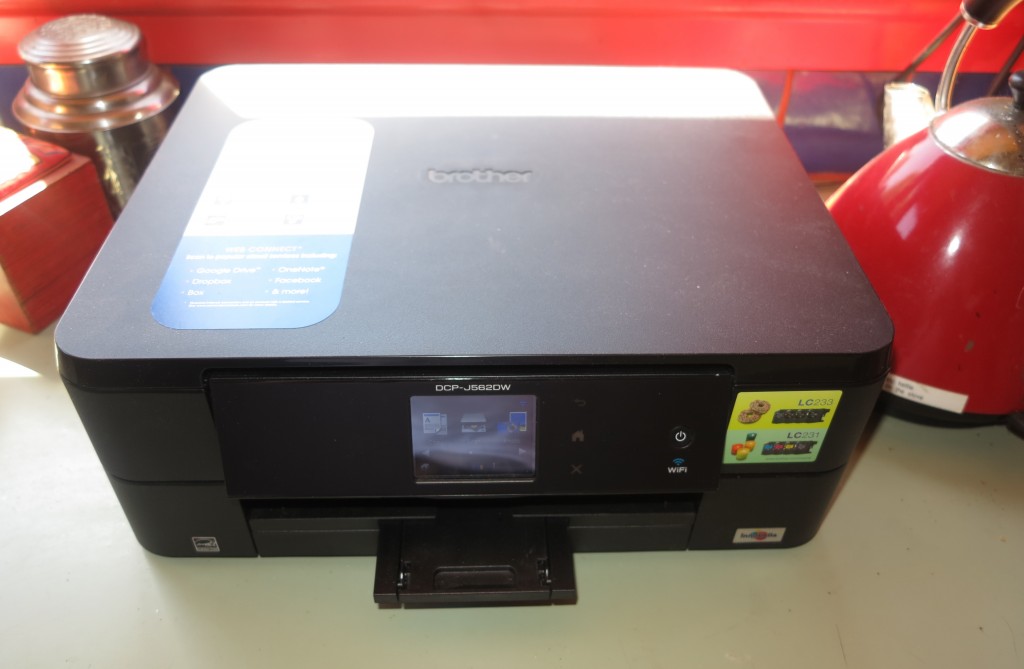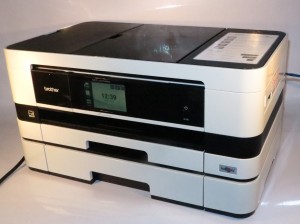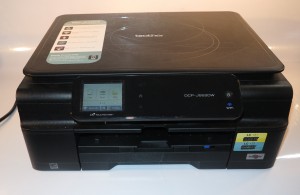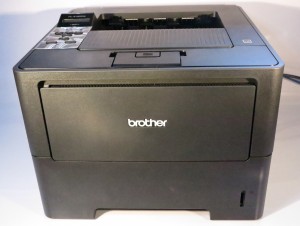Product Review–Brother DCP-J562DW Inkjet Multifunction Printer
Introduction
I am reviewing Brother’s DCP-J562DW network multifunction printer which is their latest in their lineup of compact entry-level multifunction printers.
This printer is the successor to the previously-reviewed Brother DCP-J552DW printer and uses the same inks as the MFC-J5720DW and other Brother printers released this year. There is a fax-equipped variant in the form of the MFC-J680DW which can serve well as a replacement for that old thermal-transfer fax machine that you use at home.
Photo – Insert high-resolution photo of product INLINE
| Scan | Copy | Paper Trays | Connections | |
| Colour | Colour | Colour / B/W | 1 x A4 1 x 4×6” photo |
USB 2.0 |
| Piezoelectric Ink-jet | Resolution | ID copy Optimised book copy |
Manual Bypass | 802.11g/n Wi-Fi wireless |
| Auto-duplex | multi-purpose tray | Others out of box or option List IPv6 for all machines that can work on an IPv6 network |
Prices
Printer
DCP-J562DW: AUD$129
MFC-J680DW (fax-equipped): AUD$159
Inks and Toners
| Standard | High-Capacity | |||
| Price | Pages | Price | Pages | |
| Black | AUD$33.95 | 300 | AUD$46.45 | 550 |
| Cyan | AUD$19.45 | 300 | AUD$30.50 | 550 |
| Magenta | AUD$19.45 | 300 | AUD$30.50 | 550 |
| Yellow | AUD$19.45 | 300 | AUD$30.50 | 550 |
The printer itself
At first glance, the Brother DCP-J562DW appears to be a compact printer and I even found that it is slightly deeper than an A4 page positioned vertically and has a footprint that is slightly smaller than an A3 page. This would place it in a similar league to the original HP Envy printers when it comes to how much bench space it would occupy.
Connectivity
The Brother DCP-J562DW printer can connect directly to your computer via USB or to your home network via Wi-Fi wireless. Like most of Brother’s inkjet printers, the USB cable is snaked around to a port within the printer rather than an ordinary USB port on the back. I was so amazed about how reliable it is when handling the wireless connection especially if it is placed at the fringe of your home network’s Wi-Fi coverage.
Paper handling
The Brother DCP-J562DW uses the traditional paper-feed arrangement rather than the newer landscape paper feed. There is also a bypass slot for you to put gloss paper in the back of the printer but this requires you to use one sheet at a time.
It is also worth knowing that there is a mezzanine drawer in the paper cassette so you can load a small stack of 4”x6” snapshot paper or index cards. This is pitched more at householders that want to print out snapshots from their phones or digital cameras,
Walk-up functions
The control panel clicks to the chosen operating angle yet can be folded back without you needing to operate a latch to do so. This makes for a simplified operation experience that suits most users, especially older users who may find operating these latches difficult.
I have copied a few documents including some pages from books and this printer has turned them out relatively accurately. Like most scanners, it still has a problem with newsprint by causing the “other side” of the newsprint and other thin paper to come through in the copy. The lid is hinged in such a way as to allow you to copy bound documents easily without these documents slipping or the document’s binding being damaged.
It can be difficult to gain access to the “advanced copy” functions because you have to select the functions under the “Options” menu. Here, the printer could implement one-touch access to some of these functions like what is achieved with some of the models that are higher up in the range.
There is also the ability to print from or scan to a memory card courtesy of a memory-card slot located on the left of the display behind a flap.
As for online services, the Brother DCP-J562DW supports mobile and online service in a similar manner to what the rest of Brother’s network-capable printers offer. This includes print from and scan to the popular online services, Apple AirPrint, Google; and these services can allow multiple-user enrollment as I have previously mentioned with similar products
Computer functions
Normally, when I review a printer, I try to download the software from the manufacturer’s Website. This is to obtain the latest code and also to find out how well it installs if you are loading it on to a computer that isn’t equipped with an optical drive. Here, I needed to use the supplied CD because the downloadable software came through with file-inconsistency errors for the compressed “file of files”. An alternative way to go about this would be for the installation software to be kept on the printer and for users to download it via a machine-hosted Web page for network setups or a USB Mass-Storage Device for local-connection setups.
Once I had got the driver software in to my computer, the user interface was very consistent and similar with other Brother printers. The ControlCenter scan application could benefit from a few tweaks such as being able to split and merge documents and could even support “poster-style” scanning.
Print speed and quality
The Brother DCP-J562DW turns out sharp printouts as expected for a typical home inkjet printer and the printout speed is similar for that kind of product.
The photo quality is very similar to the Brother MFC-J5720DW stablemate which uses the same print engine, with the proper contrast, brightness and definition. But the colour saturation was reduced and the skin tones in the group photograph came across more natural rather than being redder. This is a situation that I still find Brother working hard at where HP, Canon and Epson are “running ahead” with printers that are pitched for “photo-grade” printing, especially when these brands use extra colours like “photo black” or “grey” along with the standard colours.
The improvements that Brother had done with keeping a stable Wi-Fi connection have allowed this printer to turn out larger print runs even though it is on the edge of a wireless home network.
Limitations and Points Of Improvement
This printer has Wi-Fi as its only connection to the network which is a trend affecting low-end personal/home multifunction printers and their network connectivity. But I would like to still see an Ethernet connection, even as a user-installable aftermarket option, or integrated HomePlug AV500 / AV2 powerline network functionality so as to cater for difficult setups.
Personally, I would like to have all the Brother inkjet printers that are based on a particular engine or design and use a particular ink-cartridge range use all of the ink cartridge sizes that are in that range. This can reduce the need for you to think of particular cartridge sizes for particular printers especially if you purchase machines using that design.
Another feature I would like to see implemented across the board would be the landscape printing because this can lead towards a highly-compact printer that turns out the documents quickly.
Similarly, Brother could take a few cues from what HP had done with the Envy printers and the high-end Photosmart printers to design equipment that excels at aesthetics especially if they want to target such equipment for use in the main household living areas like the kitchen or family room.
Conclusion and Placement Notes
I would recommend the Brother DCP-J562DW inkjet multifunction printer or the MFC-J680DW fax-equipped variant as an option to seriously consider for a light-duty home printer.
One key application I would definitely place it for is a secondary printer to keep in the kitchen, the upstairs study or the bungalow (granny flat); or a machine that you give to your oldest child when they approach their senior secondary school or college years.





